|
BASIC QUALIFICATIONS.
Level 1 UDIP/CEDIP |
|
|
|
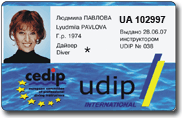 |
Module 1 |
|
| Module 2 |
"DEBUTANT" |
| Module 3 |
DIVING WITH AN INSTRUCTOR
(OR DIVEMASTER) TO A MAXIMUM DEPTH OF 20 METERS |
|
DIVER *
BASIC DIVER |
|
|
|
Prerogatives of Diver * CEDIP/UDIP or BASIC DIVER.
Diver* CEDIP/UDIP can dive to a maximum depth of 20 meters under control of an instructor (or divemaster). Minimal age of Diver* - 14 years old.
Level 2 UDIP/CEDIP
|
|
|
|
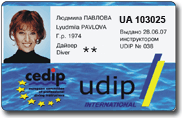 |
Module 4 |
|
| Module 5 |
DIVING IN AUTONOMOUS GROUP TO A MAXIMUM DEPTH OF 20 METERS |
| Module 6 |
DECOMPRESSION PROCEDURE
DIVING WITH AN INSTRUCTOR
(OR DIVEMASTER) TO A MAXIMUM DEPTH OF 40 METERS |
|
DIVER **
DEEP DIVER |
|
|
|
Prerogatives of Diver ** CEDIP/UDIP or DEEP DIVER.
(Decompression Procedure courses are included). Diver ** CEDIP/UDIP can dive to a maximum depth of 40 meters under supervision of an instructor (divemaster), or in autonomous group to a maximum depth of 20 meters. Minimal age of Diver** - 16 years old.
Level 3 UDIP/CEDIP
|
|
|
|
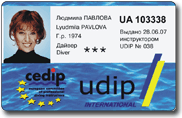 |
Module 7 |
RESCUE AND FIRST AID |
| Module 8 |
|
| Module 9 |
DIVING IN AUTONOMOUS GROUP TO A MAXIMUM DEPTH OF 40 METERS |
|
DIVER ***
AUTONOMOUS DIVER |
|
|
|
Prerogatives of Diver *** CEDIP/UDIP or AUTONOMOUS DIVER (Decompression Procedure, Rescue and First Aid courses are included).
Diver *** CEDIP/UDIP can dive to a maximum depth of 40 meters in autonomous group. Minimal age of Diver*** - 18 years old.
Level 4 UDIP/CEDIP
|
|
|
|
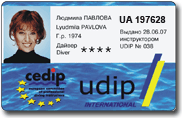 |
Module 10 |
|
| Module 11 |
|
| Module 12 |
ACCESS TO EXAMINATIONS |
DIVER ****
DIVEMASTER
|
PRACTICAL VALIDATION |
|
| THEORICAL VALIDATION |
"ASSISTANT OF INSTRUCTOR" |
|
|
|
|
Prerogatives of Diver **** CEDIP/UDIP or DIVEMASTER.
Leading group of any levels divers to a maximum depth of 40 meters. Assistant of instructor. Minimal age of Diver**** - 20 years old.
|
Level 1 UDIP/CEDIP
Module 1: Getting Acquainted to the Surroundings
- Acquiring the basics of submarine movement.
- Getting prepared for the knowledge of submarine technique.
- Discovering sensations linked to the submarine environment.
- Getting acquainted to the main changes linked to this new world.
Course Methods
Either in natural environment or in swimming pool.
Ability to Validate
1/1 Jump in water.
1/2 Submerge the face without face mask.
1/3 Control the exhalation when the face is immerged.
1/4 Swim freely.
1/5 Swim short distances under water without breathing.
1/6 To balance the pressure of the water on ear-drums.
Module 2: Basic Knowledge and Technique
- Use of personal equipment.
- Getting in the water and immersing.
- Mastering breathing.
- Group displacement in the shallow water ( 5 meters zone).
- Communicate with the instructor.
- Self mastering safety:
- on the surface.
- underwater.
Course Methods
Either in natural environment or in swimming pool.
Approximately 4 to 6 sessions.
Ability to Validate
2/1 Assemble and disassemble the equipment.
2/2 Getting equipped with individual equipment and stepping out of it.
2/3 Getting in the water (from a pier, boat).
2/4 Stay on surface by finning or by BCD (Buoyancy Control device).
2/5 Moving around with and without SCUBA.
2/6 Moving around in group.
2/7 Breath with a snorkel, with a regulator.
2/8 Going underwater and reach the bottom (shallow water).
2/9 Being able to master buoyancy using the lungs (with or without BCD).
2/10 Control the air consumption.
2/11 Know and use underwater communication code.
2/12 Receive efficiently the help of an instructor.
2/13 Being able to get involved in a 4 beginners group dive leaded by an instructor.
2/14 Follow ascent procedures made by instructor.
2/15 Master safety procedures:
- Exhalation control during the ascent.
- Clearing face mask.
- Know the theoretical basic aspects:
- Dive procedure.
- Main hazards.
- Basic knowledge of the submarine.
Module 3: To Adapt the Basic Technique to the Medium Depth Zone
- Use of a BCD.
- Enhancement of communication.
- Group displacement in the medium depth zone.
Course Methods
Validation in natural environment. Part of the training can be done in deep pools in the medium depth zone.
Approximately 6 to 8 sessions.
Ability to Validate
3/1 To use all basic techniques of module 2 in the medium depth zone.
3/2 Purge the BCD in all situations.
3/3 Stay still underwater with the help of the BCD.
3/4 Master the communication code.
3/5 Participate to own assistance.
3/6 Know the laws and regulations concerning the dive limits.
3/7 To master self-safety ascent procedures.
Level 2 UDIP/CEDIP
Module 4: Technical Enhancement
- Enhancement of basic technique.
- Increase in displacement range.
- Acquaintance to different dive conditions.
Course Methods
Validation in natural environment. Part of the training can be done in deep pools in the medium depth zone.
Approximately 8 to 12 sessions.
Ability to Validate
4/1 To adapt the equipment, the entry method to the different dive conditions.
4/2 To swimm while breathing on snorkel for 500 meters.
4/3 To swimm with SCUBA (fitted or removed) over 250 meters.
4/4 Master different immersion techniques.
4/5 Go down 4 to 6 meters without SCUBA and carry out a task.
4/6 Reach the bottom (15 to 20 meters), without the help of the anchor line.
4/7 Breath freely several times without face mask in the medium depth zone with an handicap (buoyance control, movement...).
4/8 Master individual use of a BCD.
4/9 Master buoyancy in handicapped situation (fitting and removing the SCUBA, moving with SCUBA removed).
Module 5: Evolving on Their Own in the Medium Depth Zone
- Full control of the dive in the medium depth zone with other levels 2 divers under the supervision of a dive marshal.
- Look after and assist other divers.
Course Methods
Validation in natural environment within the medium depth zone.
Approximately 12 to 20 sessions.
Ability to Validate
5/1 To follow and localise the path determined by the dive leader.
5/2 Evolve in a diving group without a dive leader
5/3 Observe the rules determined by the dive marshal.
5/4 Choose and apply the ascent procedure.
5/5 Ascent to the decompression stop and use a marker buoy to signal decompression.
5/6 Identify the problems of one of the group diver, to assist him until he is secure.
Knowledge of theoretical basic:
- Aquatic environment.
- Personal equipment of diver.
- The hazards of diving and their prevention.
- Ascent procedures.
- Laws and regulations concerning the dive limits of a level 2 diver.
Module 6: Evolution in a Deep Group Diver
- Getting acquainted to deep water.
- Getting integrated in a deep diving organization.
- Moving in guided diving group in deep water.
Course Methods
Validation in natural environment. Approximately 8 to 10 sessions.
Ability to Validate
6/1 Technical adaptation to deep water
6/2 Communication adaptation in deep water.
6/3 Equipment adaptation in deep water.
6/4 Self analysis of own problems in deep water and the ability to react.
6/5 Be able to carry out decompression stops in different situations.
Knowledge of theoretical elements:
- Hazards and prevention in deep diving.
- Procedures of deep diving.
Level 3 UDIP/CEDIP
Module 7: Hazards Prevention and Rescue Techniques
- Hazard prevention for a diving group with divers of the same level.
- Rescue and first aid in diving.
Course Methods
Validation in natural environment.
Approximately 6 to 12 sessions according to the diver`s experience (diving and first aid).
Ability to Validate
7/1 Analyze and identify all problems encountered by buddy.
7/2 Help a diver in all situations underwater.
7/3 Take out of the water a troubled diver.
7/4 Alert the rescue authorities.
7/5 Carry out first aid.
Knowledge of theoretical elements:
- Rescue organization.
- First aid in diving.
- Diving accident treatment.
Module 8: Basic Practical Organizations of a Dive
- The organization of a dive with other divers of the same level.
- The basic use of small boat for diving.
- The basic use of a portable compressor.
Course Methods
Validation in natural environment.
Approximately 3 to 4 sessions on following dives.
Ability to Validate
8/1 Choosing appropriate equipment.
8/2 Choosing a dive site.
8/3 Getting prepared on the surface and underwater on a dive site.
8/4 Choosing a mooring method and applying it.
8/5 Forecast and organize the dive procedure.
8/6 Maintenance of the equipment used.
Knowledge of theoretical elements:
- Rules and regulations.
- Environmental hazards.
- Weather bulletins.
- Reading a marine chart.
- Spotting a dive site (on surface and underwater)
- The equipment used.
- Know and respect the marine life.
Module 9: Evolving on Their Own in Deep Water
- Evolving without guidance in deep water in a group of divers having the same level.
- Acquiring knowledge to realize organizational choices.
Course Methods
Validation in natural environment, in autonomous situation under the control of an instructor (underwater).
Approximately 6 to 8 sessions
Ability to Validate
9/1 Find one`s way in deep water.
9/2 Adapt the dive pattern according to the encountered conditions.
9/3 Lead the dive group.
9/4 Apply the ascent procedure related to deep diving.
Level 4 UDIP/CEDIP
Module 10: Technical Improvements
- Mastering individual technique to become a diving group leader.
- Starting instructor training.
Course Methods
Validation in natural environment. 6 to 8 sessions.
Validation by UDIP 2nd degree instructor in accordance with a course authorized by the Chairman of the UDIP.
Ability to Validate
10/1 Cope with technical problems encountered by less experienced divers.
10/2 Rescue a less experienced diver underwater.
10/3 Performance realization.
10/4 Master own technique in imposed situations (with handicap).
Module 11: Knowledge Enhancement
- Acquiring sufficient knowledge as a diving group leader.
- Starting instructor training.
Course Methods
As theoretical courses, the length of the course is according to the start of the level evaluation.
Validation by UDIP 2nd degree instructor in accordance with a course authorized by the Chairman of the UDIP.
Ability to Validate
11/1 Knowledge of enhanced theoretical elements:
- Physics applied to diving
- Anatomy, physiology
- Accidents and hazards in diving
- Ascent procedures
- Rules and regulations
- Technology
- Knowledge of the environment.
11/2 Knowledge synthesis.
11/3 Formulate and restore own knowledge.
Module 12: Leading a Diving Group
- Organization of dive with less experienced divers under the authority of a dive marshal.
- Taking part in the organization of group diving.
Course Methods
Validation in natural environment by progressive takeover of diving group leaderhip, under the control of an instructor (underwater).
Validation by UDIP 2nd degree instructor in accordance by the Chairman of the UDIP.
Ability to Validate
12/1 Advise less experienced divers and comment the events of the dive.
12/2 Forecast the problems encountered by the less experienced divers.
12/3 Adapt the dive procedure by endorsing the recom-mendation of the dive marshal.
12/4 Take part in boat handling relevant to divers.
VALIDATION METHOD
- Validation as a final test.
- The practical module will be validated if the candidate has not been eliminated in any of the 11 test units (Ï.Ý. 1 to 11), and if he has been successful in at least 10 test units.
- All the test units of the practical module should be validated whithin 4 consecutive days. An exception can be made for bad weather conditions.
- The theoretical module will be validated if the candidate has obtained a total of 56 points without any eliminatory mark.
- The practical and theoretical modules could be split within 30 days maximum. Participation to the 2 modules is compulsory.
- In case of a single validation of one of the two modules (practical or theoretical), the candidate will be allowed a maximum time limit of 9 months to validate the missing module in 2 sessions maximum.
ORGANISATION METHOD
Authorized session obtained from the Chairman of the UDIP with application file with 1 month advance notice.
Validation by 2 UDIP instructors having 2nd degree qualification, one of them being appointed by the Chairman of the UDIP.
The written subjects will be delivered by the board of the UDIP.
The jury transmits to the board of the UDIP an examination report.
The Chairman of the UDIP delivers the level 4 diploma.
PRACTICAL VALIDATION MODULE
Demonstration of the Ability to Realize Performances
Legend: A= Validate D= Eliminate
1. Swimm 800 meters with mask, snorkel, and fins
A: Time less than 15 min 30
D: Time greater than 18 min.
2. Swimm 500 meters with SCUBA without breathing on the regulator.
A: Time less than 13 min.
D: Gave up.
3. Go down 10 meters without SCUBA and carry out a task
defined by the jury.
A: 10 m depth reached and task done.
D: 10 m depth not reached.
Technical Demonstration
4. Swimm for 100 meters with mask, snorkel, and fins. In 5 meters of water, go down for 20 seconds while finning followed by a maximum recovery time of 10 seconds on the surface. Then recover a dummy having an apparent weight of 1.5 Kg. Tow it over 100 meters.
A: Total time less than 7 min, including 20 s. breath holding. Dummy maintained with upper ways above surface.
D: Time greater than 8 min and/or dummy upper ways immersed.
5. Come up from 20 meters by finning only and without breathing on the regulator.
A: Successful ascent with constant freedom of the airways.
D: Breathes taken from the regulator before reaching the surface.
6. 20 meters ascent with a diver without the use of a BCD and bringing back him to a safe place, holding him to take out his equipment.
A: Ascent done. respect of compulsory technique. Towing and maintening efficiently performed.
D: Giving up.
7. 30 meters ascent with a diver at a constant speed, according to the ascent procedures, with the use of a BCD. Depth stabilization at 6 and 3 meters.
A: Ascent and stops at 6 and 3 meters done. Respect of compulsory techniques.
D: Stops made at depth other than 6 and 3 meters.
8. Control of individual descent in blue water, without taking any marks on the bottom, up to depth close to 40 meters according to specific criteria defined by the jury.
A: Respect of all criteria during the descent.
D: Gave up or non respect of the maximum depth defined by the jury.
9. In blue water, efficient use of the BCD for stabilization at a depth close to 40 meters with clearing of face mask.
A: Efficient stabilization. Maintening same depth level during all the exercise.
D: Refusing to clear face mask
10. Being stabilized with the BCD at a depth closed to 40 meters in blue water, react to proposed situations.
A: Adapted reactions.
D: Dangerous behavior.
Practical Demonstration on Board a Boat
11. Carry out tasks of a deck man asked by the jury.
A: Adapted response to at least 1 task out of 2.
D: Fails to all tasks.
THEORICAL VALIDATION MODULE
Giving Back Theoretical Knowledge in Writing
Answer to one or more questions concerning:
1. Physics applied to diving. Eliminated if marks less than 3/5
2. Physiology applied to diving. Eliminate if marks less than 3/5
3. Dive accidents. Eliminate if marks less than 9/15
4. Rules and regulations on diving. Eliminate if marks less than 9/15
5. Ascent procedures. Eliminate if marks less than 6/10
Giving Back Knowledge Orally
6. Carry out first aid task applied to diving, proposed by the jury. Eliminate if marks are less than 6/10
7. Answer to one or more questions concerning the diving equipment. Eliminate if marks are less than 6/10
SPECIAL QUALIFICATIONS.
Night Diving
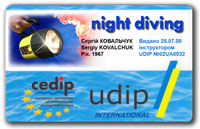
Course Methods
- UDIP/CEDIP level 2 is prerequisite level.
- Validation in natural environment.
- 4 night dive sessions under the control of a diving instructor.
- Each sessions must be organized in different conditions.
Aim of the Module
Getting acquainted to night diving in a diving group in the medium depth zone.
Capacity
- Know and understand the communication and signalling techniques:
between divers.
- between divers and the surface party.
- Know and understand the emergency procedures that apply to night diving.
Wreck Diving
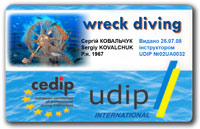
Course Methods
- UDIP/CEDIP level 2 is prerequisite level.
- At least 1 theoretical lecture.
- Validation in natural environment on a wreck site.
- 4 sessions under the control of a diving instructor.
Aim of the Module
- Preventing the specific hazards related to wreck diving.
- Getting integrated in a wreck diving organization.
Capacity
- Know and understand the specific hazards of wreck diving.
- Identify the dangerous areas of a wreck.
- Move in a guided diving group during wreck dives in the medium depth zone.
Dry Suit Diving
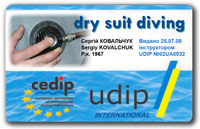
Course Methods
- UDIP/CEDIP level 2 diver being able to demonstrate the mastering of the BCD is prerequisite.
- 1 theoretical session.
- 4 sessions in natural environment.
Aim of the Module
- Getting acquainted to the dry suit technology.
- Getting familiar with the utilization of dry suits.
Capacity
- Donning techniques applicable to dry suits.
- Immersion and descent techniques using a dry suit.
- Ascent techniques using a dry suit.
- Perform dives using a dry suit.
Ice Diving
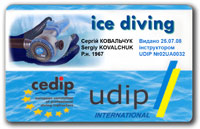
Course Methods
- Prerequisites are: UDIP/CEDIP level 2 and dry suit qualification (recommendation).
- 2 theoretical session and 3 to 4 dives on a equiped site.
Aim of the Module
Being able to practice ice diving on equiped site (lifeline...).
Capacity
- Know and understand hazards specific to cold water diving.
- Know and apply decompression procedures adapted to altitude and cold water.
- Know the ice diving equipment and how to use it.
- Manage air consumption and diving duration.
- Master the techniques to regain the surface (lifeline, beacon...).
- Manage critical situations during an ice dive.
Submarine Life
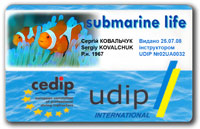
Course Methods
- UDIP/CEDIP level 1 is prerequisite.
- Validation in natural environment.
- 4 sessions including a theoretical lecture followed by a dive.
Aim of the Module
- Identify the different forms of submarine life encountered during a dive.
- Observing and understanding submarine life.
Capacity
- Identify the main phylums of the submarine life.
- Identify the main species encountered in a dive zone.
- Know the main specificity of submarine life.
UW photography
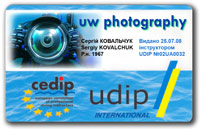
Course Methods
- UDIP/CEDIP level 1 is prerequisite.
- 4 theoretical sessions.
- 4 sessions in natural environment to practice underwater photography under the control of a diving instructor.
Aim of the Module
- Getting acquainted to taking pictures using underwater photography equipment.
- Preventing hazards specific to underwater photography activity.
- Preparing and maintaining underwater photography equipment.
Capacity
- Basic knowledge of underwater photography techniques using amphibious camera, housed camera, and flashgun:
- Setting exposure.
- Focusing
- Framing
- Know and understand hazards of underwater photography activity.
- Prepare the underwater photography equipment, load and unload film.
- Handle properly the underwater photography equipment underwater and on board a diving boat.
- Maintain efficiently underwater photography equipment.
- Perform the basic analysis of underwater pictures.
Underwater Video
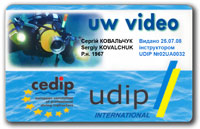
Course Methods
- UDIP/CEDIP level 1 is prerequisite.
- 4 theoretical sessions.
- 4 sessions in natural environment to practice underwater video under the control of a diving instructor.
Aim of the Module
- Getting acquainted to film shooting using underwater video equipment.
- Preventing hazards specific to underwater video activity.
- Preparing and maintaining underwater video equipment.
Capacity
- Basic knowledge of film shooting techniques using underwater video equipment:
- Balancing whites.
- Framing
- Floodlighting
- Shooting techniques (shot, medium shot, close-up).
- Preparing a film script.
- Being introduced to basic film editing (cutting) principles.
- Know and understand hazards of underwater video activity.
- Prepare the underwater video equipment, load and unload video tape.
- Handle properly the underwater video equipment underwater and on board a diving boat.
- Maintain efficiently underwater video equipment.
- Perform the basic analysis of underwater video rushes.
|